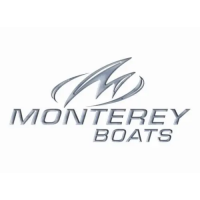
Do you have a question about the Monterey 400 Sport and is the answer not in the manual?
Covers structural defects in the hull and deck for the life of ownership.
Offers a 10-year transferable warranty for structural hull and deck defects.
Details the Inboard Power System (IPS) drives and their maintenance.
Overview of gauges and instruments used to monitor engine operation.
Details electronic engine controls and binnacle style levers for throttle and shift.
Describes the electronic IPS steering system and its features.
Explains the operation and control of trim tabs for hull attitude adjustment.
Details the boat's fuel tank configuration and withdrawal tube placement.
Covers the diesel fuel system, including tank connections and fuel quality.
Details the importance and maintenance of diesel fuel filters.
Provides a step-by-step guide for fueling the boat safely at a marina.
Outlines periodic inspections and maintenance for the fuel system.
Overview of the boat's AC and DC electrical systems and battery types.
Explains the standard 12-volt system, battery charging, and parallel features.
Details the location and operation of remote battery switches and battery banks.
Instructions for paralleling batteries in case of a dead battery.
Details the boat's 120-volt AC system and shore power connections.
Step-by-step guide for connecting to shore power safely.
Explains selector switches for shore power or generator supply.
Monitors AC volts, load amps, and frequency for panel accessories.
Controls for starting, running, and stopping the generator.
Switches control generator starting, running, and stopping.
Details the generator's activation, maintenance, and operation.
Maintenance for the 12-volt DC and AC electrical systems.
Helps document and manage electrical load from AC accessories.
Instructions for filling the water tank and operating the pump.
Details the location and operation of the 120-volt water heater.
Routine maintenance tasks for the fresh water system.
Describes self-contained, sea water cooled air conditioning units.
Details the three bilge pumps, their activation, and protection.
Importance of proper ventilation to prevent carbon monoxide buildup.
Describes the engine compartment ventilation system.
Location of steering, controls, instruments, and electronics at the helm.
Description of aft and forward head compartments with sinks and toilets.
Operation of the VacuFlush marine head system using water and vacuum.
Details the holding tank, vacuum generators, and macerator pump.
Installation and function of CO detectors in cabins.
Operation of reverse cycle air conditioning units for cooling and heating.
Details the standard and optional entertainment system components.
Explains engine alarms for water temperature and oil pressure monitoring.
Lists essential safety equipment required by the U.S. Coast Guard.
Information on the number, type, and location of fire extinguishers.
Discusses the dangers of fuel and bilge fires and actions to take.
Details the engine compartment automatic fire extinguishing system.
Explains the function and importance of CO detectors on board.
Emphasizes familiarizing with systems and performing precruise checks.
Basic navigation rules for safe boating operation in inland waters.
Checklist of essential items and checks before starting the engines.
Procedures and responsibilities for operating the boat safely.
Techniques for maneuvering, docking, anchoring, and mooring.
Maneuvering near docks and securing the boat with dock lines.
Actions to take if control or propulsion systems fail.
Procedures to follow in the event of a boat collision.
Guidelines for handling grounding, towing, or assisting vessels.
Actions to take if the boat becomes flooded or capsizes.
Procedures for recovering a person who has fallen overboard.
Procedures for cleaning and maintaining the hull and deck.
Information on hull painting processes and materials for blister prevention.
Details on checking and replacing sacrificial anodes for corrosion protection.
Guidelines for maintaining the fiberglass hull's gelcoat surface.
Maintaining a clean and fresh bilge and engine compartment.
Importance of proper engine maintenance and fuel quality.
Procedures for preparing the boat for lay-up and storage.
Steps to take before hauling the boat, including tank pumping and fuel.
Proper procedures and sling locations for lifting the boat.
Best practices for supporting the boat during storage.
Comprehensive winterizing procedures for boat systems.
Winterizing steps for the entire fresh water system.
Draining sea strainers and raw water lines for engines and generator.
Steps to take to prepare the boat for use after storage.
Solutions for common problems with steering and engine controls.
Common engine issues and their potential causes and solutions.